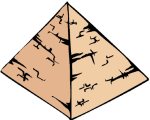Have you tried my current affairs? Stay informed.
Also, fiction and poetry.
 Sacred geometry is an ancient system of design and building based upon the harmonic relationship between man, nature and the universe. Virtually ignored by modern architects and designers, it was central to most ancient societies.
Sacred geometry is an ancient system of design and building based upon the harmonic relationship between man, nature and the universe. Virtually ignored by modern architects and designers, it was central to most ancient societies.
The practice concerns a worldview of pattern recognition, producing religious patterns and structures involving space, time and form. By working with such forms, insight can come regarding the nature of all.
It often involves mathematics.
 Pythagoras realized the importance of this, and also showed how such harmonies work also with music. Hence, sacred geometry is a holistic practice. Even in ancient cave art, it is now known that pictures were drawn at ideal places for sound amplification.
Pythagoras realized the importance of this, and also showed how such harmonies work also with music. Hence, sacred geometry is a holistic practice. Even in ancient cave art, it is now known that pictures were drawn at ideal places for sound amplification.
These principles seem to have been instinctual in ancient times, but science is also discovering such harmonies. Indeed, it has led some to wonder at the incredible coincidences of exact balance that led to the universe in the first place.
Sacred design is therefore a reflection of the universe.
In this sense, perfection is vital to the process. Originally found in man’s expression of his relationship with Mother Earth, we find the earth mound. Later, math led to greater perfection in the pyramid, or other construction that aligned with the solstice dawn.
However, an understanding of this harmonic relationship can often cause too much complication in just what sacred geometry is about. I say this because ancient man seemed to realize such relationships, and design accordingly, through instinct.
The urge to perfection was just as great.
But such perfection was more about symbolism than mathematical design. It seemed to be more a physical representation of the spiritual, as is seen even today in the ‘form’ of a church. Shaped as a cross, when you walk into a church, you actually walk into the body of Christ.
Bearing this in mind, could it be that there is a far more important psycho-sociological understanding to be had from sacred geometry? I think there is – and an understanding that can tell us a great deal about ourselves, even today.
 Sacred geometry gives a sense of permanence.
Sacred geometry gives a sense of permanence.
Whilst math became important in terms of geometric perfection, I think it is this sense of permanence that is primary. It said, in bold majesty, that this represents a system that is here to stay and is fundamental to who you are.
This anchors a particular society within a specific culture. You just have to look at cities through the ages to see it in operation. First, the temple was the biggest structure at its centre. In the west, this was replaced first by the cathedral, then the factory, and, today, the trade centre or bank.
In each case the prominent building reflects the society of the time, be it Christendom, industrial or super-capitalist. And whilst the last two certainly didn’t seem to have anything to do with sacred geometry, in this respect they do. Indeed, it suggests we are still, today, enslaved by the ‘sacred’ culture they instill in us.
But it also suggests a question. Does sacred geometry reflect the universe, or does it create, in us, a universal image of ourselves, and what we aspire to be? Perhaps we need to understand this as a possibility, and use it for the good rather than an unconscious form of control.
© Anthony North, November 2008